Companies are making massive AI investments, yet 60% of AI initiatives fail to deliver real business impact. As a business leader, you're not just looking to adopt AI; you need to make it work. However, without the right integration, AI remains an expensive experiment rather than a strategic advantage.
The problem isn't the technology itself, it's how businesses integrate it. While companies like Amazon and Tesla are using AI to optimize operations and dominate their industries, many others struggle with fragmented implementations, rising costs, and siloed data. A McKinsey study found that while 63% of executives expect AI to drive revenue growth, only 23% have successfully scaled it. The gap? A lack of structured AI integration.
The AI landscape is evolving rapidly. Companies that integrate AI strategically today will shape the next generation of industry leaders. In this article, we'll explore five types of AI integration, how they work, real-world applications, and their business impact so you can transform AI from a buzzword into a high-ROI growth engine before your competitors do.
Understanding AI integration: Why it matters for business success
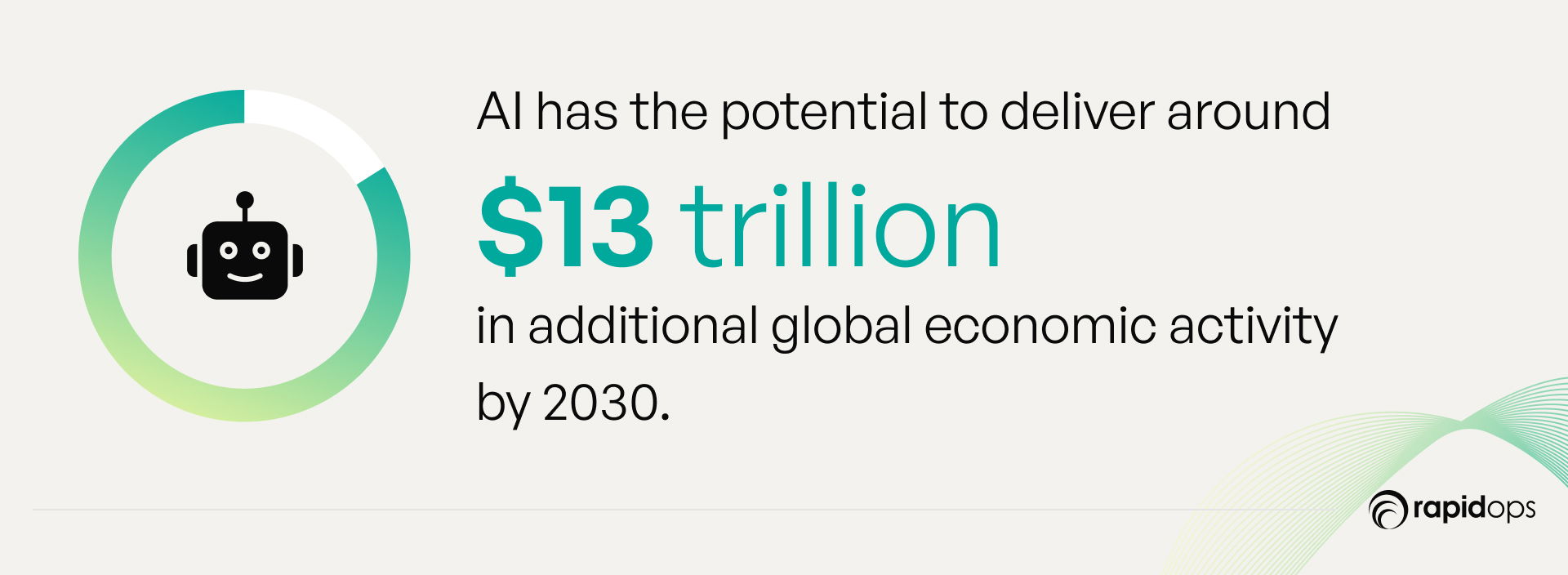
AI integration is far more than a technological upgrade; it's a business strategy. When AI is strategically embedded into core business functions, it can improve efficiency, foster innovation, and open doors to new revenue streams.
However, simply adopting AI is not enough; how businesses integrate AI determines its effectiveness. Poor integration, on the other hand, can lead to siloed tools, inefficiencies, and missed opportunities. Aligning AI with business goals is the first step to achieving measurable ROI. By carefully selecting the right AI integration method, whether cloud, on-premises, or hybrid, companies can streamline operations, enhance decision-making, and better meet customer demands.
The 5 key methods of AI integration
AI integration involves embedding artificial intelligence into business operations to drive performance improvements, enhance decision-making, and streamline workflows through machine learning, data analytics, and automation. The following five key methods of AI integration provide strategic pathways for aligning technology with business objectives, ensuring long-term growth and a competitive advantage.
1. API-based AI integration
What it is
API-based AI integration enables businesses to embed artificial intelligence capabilities into their existing infrastructure without a complete overhaul. Application Programming Interfaces (APIs) act as intermediaries, facilitating real-time data exchange between AI models and business systems. This seamless connectivity allows AI to analyze, predict, and respond to data-driven inputs while maintaining operational continuity. By integrating AI incrementally, companies can enhance functionality without disrupting daily operations.
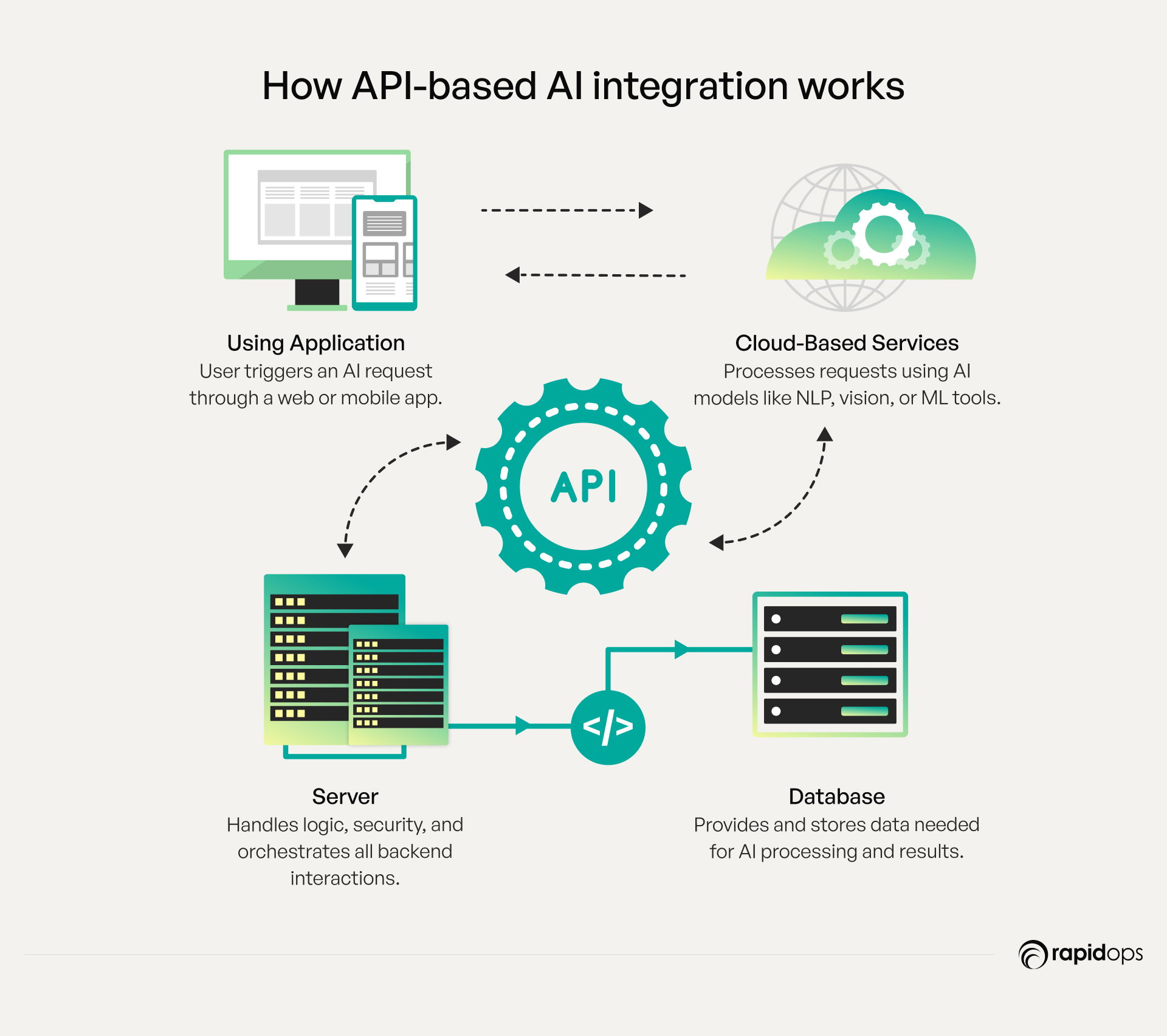
Best for
Businesses aiming to accelerate AI adoption while preserving operational stability. This model is particularly beneficial for industries that rely on real-time data processing, such as financial services, eCommerce, and logistics. It enables organizations to integrate AI-driven automation, enhance customer interactions, and strengthen risk management without the complexities of system-wide overhauls. Companies looking for a modular, cost-effective approach to AI integration, allowing them to scale capabilities incrementally while remaining agile in a rapidly evolving market, will find API-based integration invaluable.
Use cases
Customer Service Automation: Retailers like H&M integrate AI-powered chatbots via APIs to enhance customer support, reducing response times and improving service quality while ensuring 24/7 availability.
- Fraud detection: Financial institutions like Mastercard utilize API-based AI to detect anomalies in real-time transactions, mitigating fraud risks and strengthening security.
- Predictive analytics: Amazon employs AI-driven forecasting through API integration, optimizing inventory levels, reducing waste, and improving supply chain efficiency.
Business impact
API-based AI integration offers a scalable and cost-effective approach to AI adoption, ensuring minimal disruption to core business processes. With advanced API management tools like Kong and Apigee, companies can monitor AI performance, optimize workflows, and maintain system reliability. By leveraging APIs, businesses can accelerate AI-driven innovation without costly infrastructure overhauls, reducing time to market for new AI capabilities.
Key takeaway
For companies seeking an agile AI adoption strategy, API-based integration provides a low-risk, high-impact solution. By embedding AI into existing workflows via APIs, businesses can achieve measurable improvements, such as reducing operational costs by up to 20% within the first year. To maximize AI’s potential, companies should assess their API readiness and identify high-impact areas where AI can drive efficiency and business growth.
2. Embedded AI integration
What it is
Embedded AI integrates artificial intelligence directly into business operations, transforming core processes through automation and data-driven insights. This approach enhances real-time decision-making, boosts efficiency, and strengthens scalability, providing businesses with a sustainable competitive advantage. It allows organizations to unlock AI’s potential without the need for disruptive system overhauls.
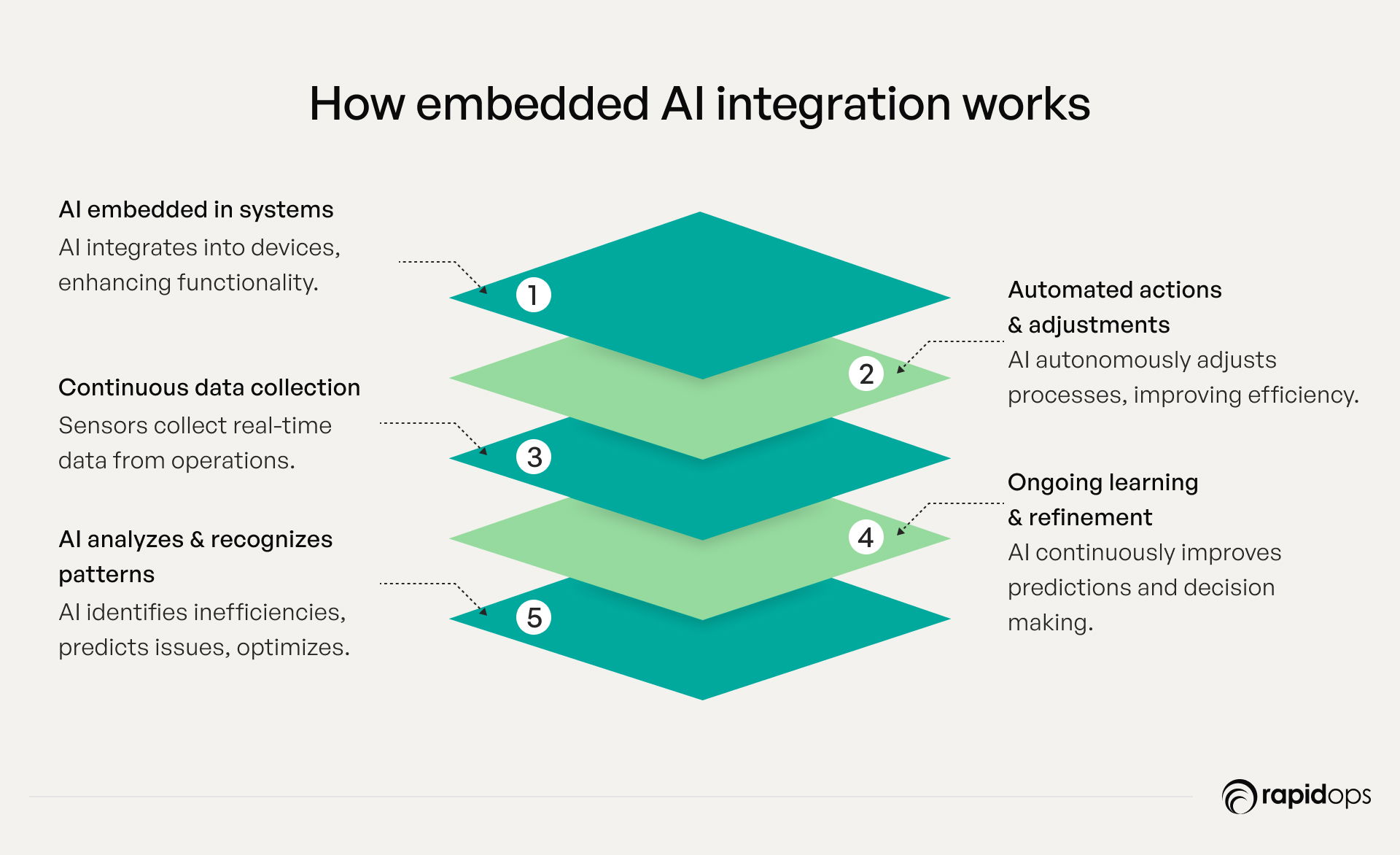
Best for
Businesses looking for long-term operational efficiency and aiming to embed AI-driven automation into critical functions like production, logistics, and customer engagement will benefit most from embedded AI. This method is ideal for organizations that want to use AI as a strategic enabler of transformation and growth.
Use cases
- Smart manufacturing: Siemens uses embedded AI in its manufacturing processes for predictive maintenance and quality control, reducing equipment downtime and improving production quality by identifying potential failures before they occur. This has helped Siemens reduce maintenance costs and improve uptime in manufacturing operations.
- AI-driven logistics: UPS integrates embedded AI into its logistics network for route optimization and real-time tracking of packages. The AI analyzes data such as traffic conditions, weather, and delivery patterns to optimize delivery routes, reducing fuel consumption and improving service speed.
Business impact
Embedded AI drives higher operational efficiency by automating key functions and improving decision-making in real time. This integration method helps businesses achieve long-term scalability and cost reductions. However, it requires a more sophisticated AI infrastructure and technical expertise for proper implementation and management.
Key takeaway
Embedding AI into core business operations leads to sustained improvements in efficiency and cost savings. For example, UPS’s AI-based route optimization resulted in a 10% reduction in fuel costs and a 20% improvement in delivery times, demonstrating the power of AI in driving operational excellence.
Businesses that strategically integrate AI in this way can expect transformational growth, faster decision-making, and a more competitive edge in the market.
3. Cloud-based AI integration
What it is
Cloud-based AI integration refers to the deployment of AI systems through cloud platforms, allowing businesses to access powerful AI tools without the need for significant upfront investments in infrastructure. This method enables companies to scale their AI capabilities quickly and cost-effectively by leveraging cloud service providers’ infrastructure. Cloud-based AI systems are flexible, scalable, and continuously updated, providing businesses with the agility to respond to changing demands.
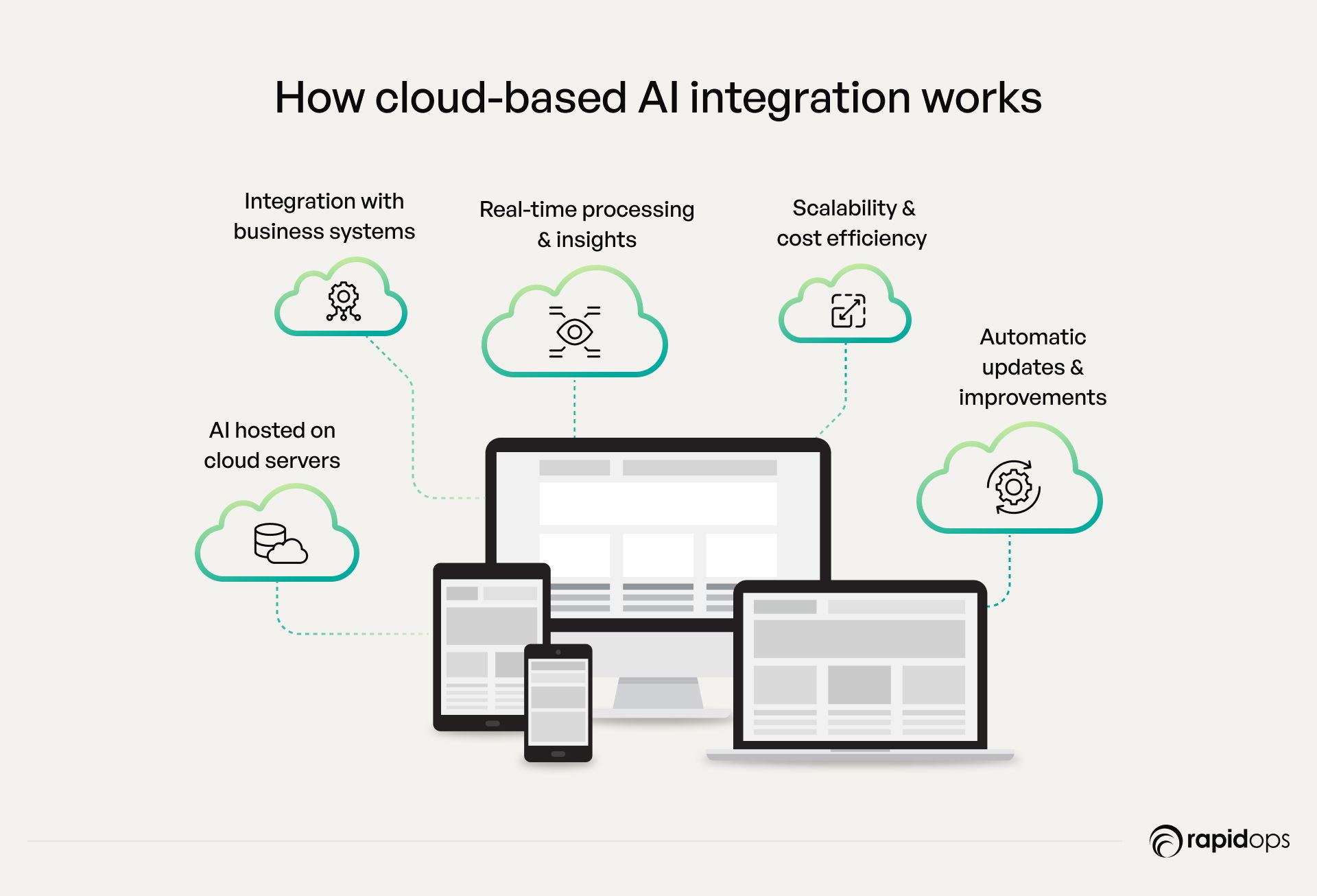
Best for
Cloud-based AI is ideal for businesses that want to scale rapidly while minimizing costs. It’s particularly useful for companies looking to implement AI solutions without the burden of managing extensive hardware or IT infrastructure. This method offers quick deployment, making it a strong choice for businesses in dynamic industries that need to adapt quickly to market shifts.
Use cases
- AI-powered analytics platforms: Netflix uses cloud-based AI to provide personalized recommendations to its users based on viewing history and preferences. This enhances the customer experience by tailoring content suggestions to individual tastes, leading to increased engagement and retention.
- Cloud-based virtual assistants: Both Google Assistant and Amazon Alexa rely on cloud-based AI for real-time processing and continuous improvement, offering personalized, voice-activated assistance that gets smarter with use.
- Cloud-based automation: Slack uses cloud-based AI to automate workflow management, helping teams streamline collaboration and task management without needing heavy manual input, improving productivity and team efficiency.
Business impact
Cloud-based AI offers several key advantages:
- Flexibility and agility: Businesses can scale AI solutions up or down quickly depending on their needs.
- Cost-effective: With no need for large upfront infrastructure investments, cloud-based AI offers a lower barrier to entry.
- Scalability: Cloud solutions allow businesses to expand their AI capabilities as they grow, ensuring that AI continues to support operations efficiently.
However, reliance on cloud providers means that businesses must ensure reliable partnerships for data security, uptime, and performance.
Key takeaway
Cloud-based AI integration provides quick deployment, minimal infrastructure needs, and cost-efficiency. For business leaders, this translates into faster time-to-market for AI-powered solutions, making it easier to test and scale AI applications without heavy financial commitment.
Companies that have adopted cloud-based AI report a 30% reduction in infrastructure costs, illustrating its potential to drive substantial cost savings. For businesses aiming to leverage AI with flexibility and speed, cloud-based integration is a strategic choice that offers both scalability and operational efficiency.
4. On-premises AI Integration
What it is
On-premises AI integration involves deploying AI solutions directly within a company’s own infrastructure, giving businesses full control over their data, models, and security. Unlike cloud-based AI, which relies on third-party providers, on-premises integration keeps AI models and data internal, offering greater customization, data sovereignty, and security, key factors for industries that handle sensitive information.
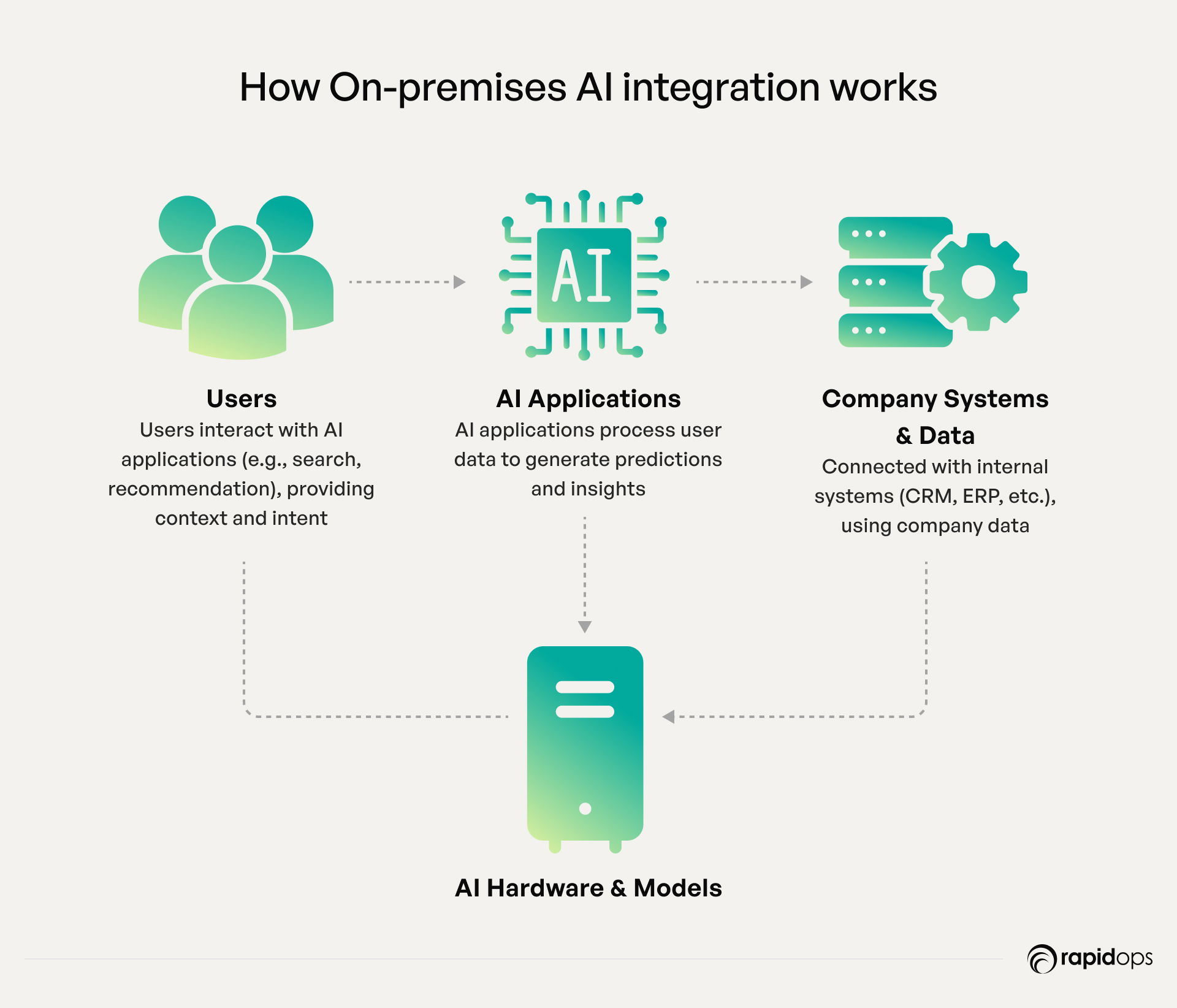
Best for
On-premises AI integration is ideal for businesses in highly regulated sectors, such as manufacturing, retail, and logistics, where maintaining strict control over data, meeting regulatory compliance, and ensuring data privacy are critical priorities. This method offers businesses full autonomy, making it well-suited for those with specific customization needs and stringent operational requirements.
Use cases
- Manufacturing: On-premises AI enables predictive maintenance in manufacturing by analyzing real-time machine data to predict failures before they happen. AI models are embedded into manufacturing systems to continuously monitor equipment performance. These models can predict when a machine needs maintenance, enabling timely repairs and minimizing downtime.
- Retail: On-premises AI in retail optimizes inventory management and personalized pricing strategies. AI models analyze sales data, customer preferences, and external factors like weather to predict demand and optimize stock levels in real time. This allows businesses to adjust prices dynamically based on demand and customer behavior.
Business impact
On-premises AI integration offers numerous benefits:
- Control and security: Hosting AI solutions internally ensures complete control over data and AI models. This is particularly beneficial in industries like manufacturing, retail, and logistics, where regulatory compliance and data security are crucial.
- Customization: With on-premises AI, businesses can tailor solutions to meet specific operational needs, ensuring better alignment with business goals. This allows for improved efficiency, accuracy, and workflow integration.
- Investment and maintenance: Although on-premises AI requires a significant initial investment in infrastructure and maintenance, it provides long-term benefits in terms of data privacy, customization, and regulatory compliance.
Key takeaway
For business leaders in manufacturing and retail, on-premises AI integration offers maximum control and security, making it ideal for industries that require stringent data governance. While the upfront investment is higher than cloud-based solutions, the long-term advantages, including regulatory compliance, customization, and enhanced operational efficiency, make it a strategic solution.
Integrating AI into core processes helps businesses reduce downtime, improve inventory management, enhance customer experiences, and optimize operations for sustainable growth.
5. Hybrid AI integration
What it is
Hybrid AI integration combines the scalability and flexibility of cloud-based AI with the control and security of on-premises AI. This approach enables businesses to leverage the strengths of both models, offering enhanced data privacy, regulatory compliance, and scalability, making it an ideal solution for industries that require flexibility but also need stringent data control.

Best for
Hybrid AI is perfect for organizations that must comply with industry regulations or handle sensitive data, such as those in retail, manufacturing, and logistics. This integration method allows businesses to store sensitive data on-premises for control and compliance, while also utilizing cloud services for scalability and cost-efficiency.
Use cases
Retail AI-driven personalization
Retailers use hybrid AI to deliver personalized recommendations and optimize inventory management. By leveraging cloud-based scalability to handle large amounts of real-time customer data and using on-premises systems to store sensitive customer information, businesses can scale their personalization strategies while maintaining full data control and compliance.
Supply chain optimization
Manufacturers like Toyota integrate hybrid AI to manage supply chain data in real-time. Combining cloud AI for global data processing with on-premises systems for regulatory compliance, they ensure operational efficiency while adhering to local regulations, thus creating a seamless workflow across the supply chain.
Business impact
Hybrid AI integration offers businesses the best of both worlds:
- Scalability: Cloud capabilities allow companies to expand AI operations quickly and efficiently, adapting to fast-changing markets.
- Control & security: On-premises systems give businesses the ability to securely store and manage sensitive data, maintaining control while meeting compliance requirements.
- Flexibility & efficiency: This dual approach helps companies optimize workflows, reduce operational risks, and improve efficiency.
However, the integration requires careful strategic planning to balance the need for flexibility and data security, ensuring companies get the most out of both approaches without compromising on their core objectives.
Key takeaway
For business leaders, hybrid AI integration provides a solution that combines the scalability of cloud-based AI with the security and control of on-premises AI. This approach is ideal for businesses managing sensitive data while scaling operations.
Companies that use hybrid AI systems typically see a 20% improvement in efficiency and 30% reduction in risk, ensuring strong ROI while maintaining compliance. Hybrid AI is a strategic choice for businesses looking to stay agile in an evolving digital landscape.
Key considerations for successfully integrating AI into your business
Integrating AI into your business isn’t just about deploying technology—it’s about strategically embedding AI to support your broader organizational goals. For business leaders and decision-makers i, here are key aspects to consider ensuring that AI delivers maximum value and aligns with your business strategy.
Aligning AI with business goals
AI should not be seen as just a tool for automating tasks but as a strategic enabler of business transformation. Successful AI integration begins with aligning the technology with your company’s core objectives, whether it’s enhancing customer experience, improving operational efficiency, or driving innovation.
- Why it matters: AI will only provide meaningful results if it’s integrated in ways that directly impact your business outcomes. For example, automating processes without a clear strategy or alignment can lead to wasted resources and underwhelming results.
- Actionable insight: Start by identifying which areas of your business would benefit the most from AI, whether it’s personalization in retail, predictive maintenance in manufacturing, or AI-powered analytics in finance. Align AI initiatives with your strategic goals to ensure that every AI tool or solution directly supports your business vision.
Data readiness
The effectiveness of AI is directly tied to the quality, security, and governance of your data. AI models rely on vast datasets, and without clean, structured, and secure data, your AI system will not produce accurate or actionable insights.
- Why it matters: AI models are only as good as the data they are trained on. Poor-quality or unsecured data can lead to biased outcomes, regulatory risks, and suboptimal performance.
- Actionable insight: Assess your organization’s data infrastructure to ensure data is properly collected, stored, and managed. Ensure data is clean, accurate, and compliant with regulations like GDPR or HIPAA, depending on your industry.
Scalability & flexibility
AI integration should be designed with growth in mind. As your business evolves, so should your AI systems. Choose integration methods that can scale as your business expands, without requiring a complete overhaul of the system.
- Why it matters: A flexible AI system can grow and adapt with your business, whether that means handling more data, accommodating more customers, or integrating new AI capabilities.
- Actionable insight: Choose AI solutions that offer modularity and cloud scalability, so you can easily scale up or add new capabilities as needed without disrupting current operations.
Cost vs. ROI
AI integration can involve significant upfront investment in infrastructure, software, and skilled personnel. The key to successful AI adoption lies in balancing initial costs with the long-term value it brings. C-suite leaders must carefully evaluate potential ROI based on specific use cases and business outcomes.
- Why it matters: Cost-effective AI solutions can provide quick wins, but the long-term success of AI relies on ensuring that these investments pay off through improved efficiency, increased revenue, or cost savings.
- Actionable insight: Develop a clear ROI model for your AI integration project, factoring in both tangible and intangible benefits. Calculate expected ROI based on real-world use cases, like cost savings from automation or increased revenue through personalized marketing.
Regulatory & ethical considerations
As AI becomes more embedded in business processes, regulatory compliance and ethical considerations are critical. AI systems must be transparent, fair, and accountable to avoid bias, discrimination, or violating data privacy laws.
- Why it matters: Failing to comply with data privacy laws or using biased AI algorithms can result in legal issues, reputational damage, and loss of customer trust.
- Actionable insight: Stay informed about industry regulations and ensure that your AI systems are transparent, explainable, and built on ethically sound principles. Implement processes to regularly audit AI models for fairness and bias.
Choosing the right AI integration for lasting business impact
Every business stands at a crossroads with AI. Some rush in, implementing disconnected solutions that create more complexity than progress. Others hesitate, unsure of the right approach, watching competitors move ahead. But those who strategically integrate AI, aligning it with their goals, workflows, and teams, unlock real transformation.
AI isn’t just about automating tasks; it’s about empowering your people, refining decision-making, and creating a foundation for long-term innovation. Whether it’s a cloud-based system for agility, an embedded solution for real-time insights, or a hybrid approach balancing flexibility and control, the right AI model fuels efficiency, growth and resilience.
At Rapidops, we’ve helped businesses move beyond AI experimentation to real-world impact, seamlessly integrating AI where it delivers the most value. The next move is yours. Let’s map out a strategy that makes AI work for you. Schedule a call with our experts, and we’ll build a smarter path forward together.

Rahul Chaudhary
Content Writer
With 5 years of experience in AI, software, and digital transformation, I’m passionate about making complex concepts easy to understand and apply. I create content that speaks to business leaders, offering practical, data-driven solutions that help you tackle real challenges and make informed decisions that drive growth.

Let’s build the next big thing!
Share your ideas and vision with us to explore your digital opportunities
Similar Stories
- AI
- 4 Mins
- September 2022

- AI
- 9 Mins
- January 2023


Receive articles like this in your mailbox
Sign up to get weekly insights & inspiration in your inbox.

